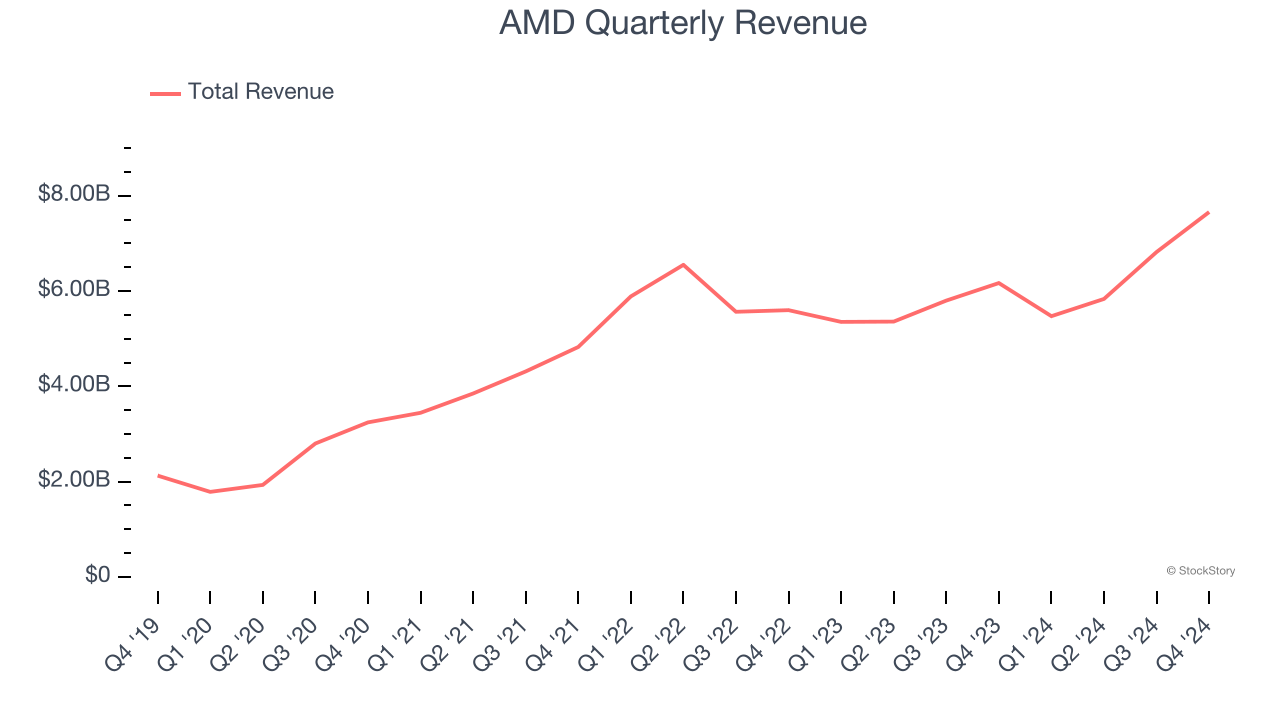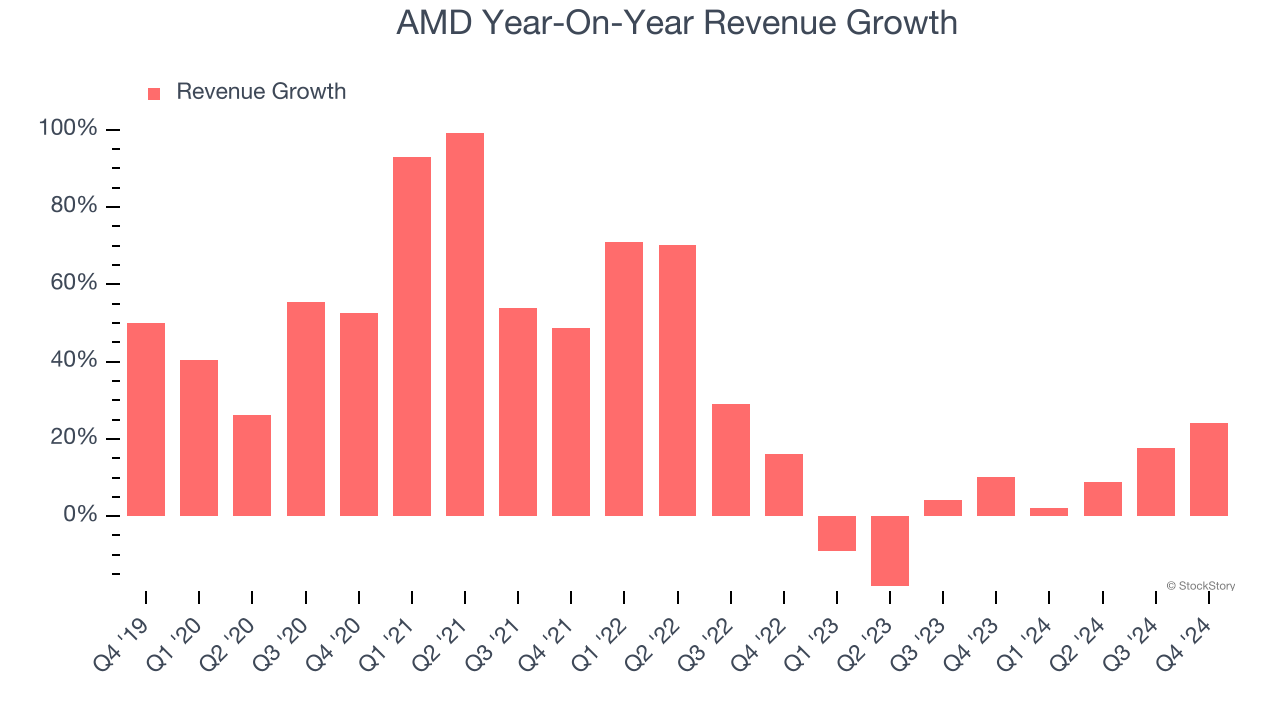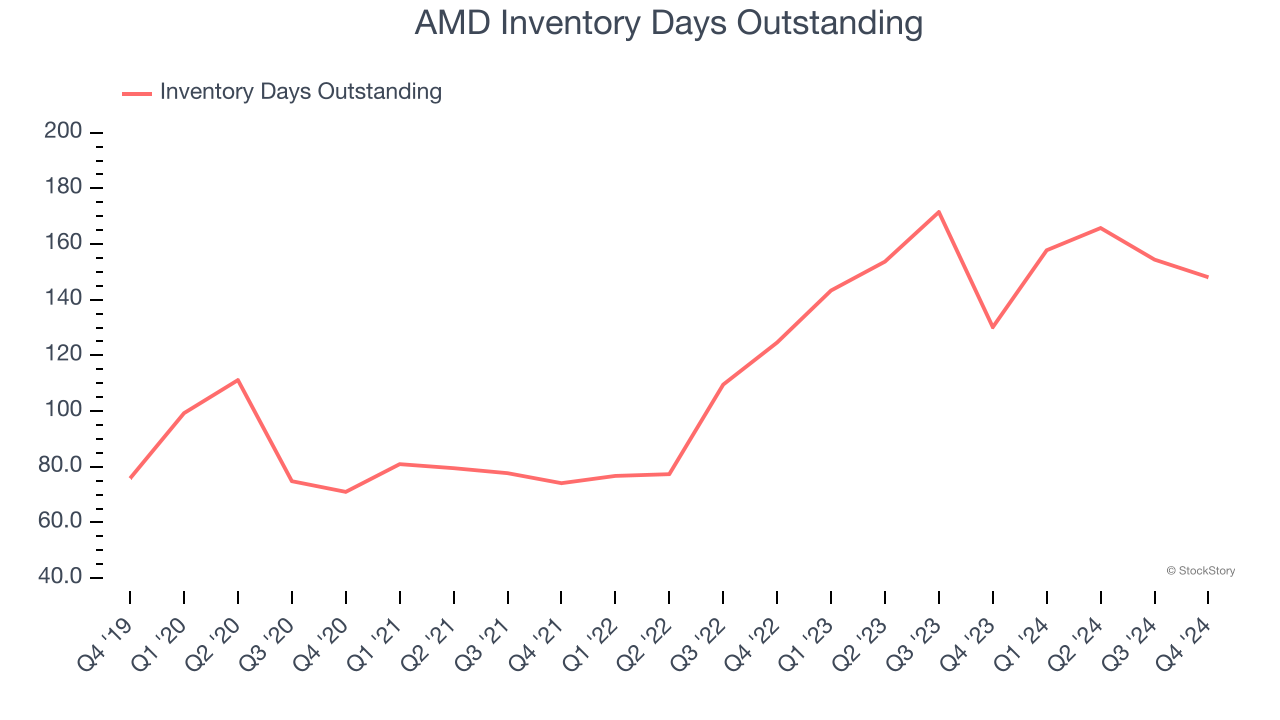
Computer processor maker AMD (NASDAQ:AMD) beat Wall Street’s revenue expectations in Q4 CY2024, with sales up 24.2% year on year to $7.66 billion. Guidance for next quarter’s revenue was better than expected at $7.1 billion at the midpoint, 1.3% above analysts’ estimates. Its non-GAAP profit of $1.09 per share was in line with analysts’ consensus estimates.
Is now the time to buy AMD? Find out by accessing our full research report, it’s free.
AMD (AMD) Q4 CY2024 Highlights:
- Revenue: $7.66 billion vs analyst estimates of $7.54 billion (24.2% year-on-year growth, 1.5% beat)
- Adjusted EPS: $1.09 vs analyst estimates of $1.09 (in line)
- Adjusted EBITDA: $2.21 billion vs analyst estimates of $1.82 billion (28.9% margin, 21.2% beat)
- Revenue Guidance for Q1 CY2025 is $7.1 billion at the midpoint, above analyst estimates of $7.01 billion
- Gross Margin Guidance for Q1 CY2025 is 54% at the midpoint, slight below analyst estimates
- Operating Margin: 11.4%, up from 5.5% in the same quarter last year
- Free Cash Flow Margin: 14.2%, up from 3.9% in the same quarter last year
- Inventory Days Outstanding: 148, down from 154 in the previous quarter
- Market Capitalization: $185.4 billion
“2024 was a transformative year for AMD as we delivered record annual revenue and strong earnings growth,” said AMD Chair and CEO Dr. Lisa Su.
Company Overview
Founded in 1969 by a group of former Fairchild semiconductor executives led by Jerry Sanders, Advanced Micro Devices (NASDAQ:AMD) is one of the leading designers of computer processors and graphics chips used in PCs and data centers.
Processors and Graphics Chips
The biggest demand drivers for processors (CPUs) and graphics chips at the moment are secular trends related to 5G and Internet of Things, autonomous driving, and high performance computing in the data center space, specifically around AI and machine learning. Like all semiconductor companies, digital chip makers exhibit a degree of cyclicality, driven by supply and demand imbalances and exposure to PC and Smartphone product cycles.
Sales Growth
A company’s long-term sales performance can indicate its overall quality. Any business can put up a good quarter or two, but many enduring ones grow for years. Luckily, AMD’s sales grew at an incredible 30.8% compounded annual growth rate over the last five years. Its growth beat the average semiconductor company and shows its offerings resonate with customers, a helpful starting point for our analysis. Semiconductors are a cyclical industry, and long-term investors should be prepared for periods of high growth followed by periods of revenue contractions.

We at StockStory place the most emphasis on long-term growth, but within semiconductors, a half-decade historical view may miss new demand cycles or industry trends like AI. AMD’s recent history shows its demand slowed significantly as its annualized revenue growth of 4.5% over the last two years is well below its five-year trend. 
This quarter, AMD reported robust year-on-year revenue growth of 24.2%, and its $7.66 billion of revenue topped Wall Street estimates by 1.5%. Company management is currently guiding for a 29.7% year-on-year increase in sales next quarter.
Looking further ahead, sell-side analysts expect revenue to grow 24.1% over the next 12 months, an improvement versus the last two years. This projection is eye-popping for a company of its scale and implies its newer products and services will fuel better top-line performance.
Unless you’ve been living under a rock, it should be obvious by now that generative AI is going to have a huge impact on how large corporations do business. While Nvidia and AMD are trading close to all-time highs, we prefer a lesser-known (but still profitable) stock benefiting from the rise of AI. Click here to access our free report one of our favorites growth stories.
Product Demand & Outstanding Inventory
Days Inventory Outstanding (DIO) is an important metric for chipmakers, as it reflects a business’ capital intensity and the cyclical nature of semiconductor supply and demand. In a tight supply environment, inventories tend to be stable, allowing chipmakers to exert pricing power. Steadily increasing DIO can be a warning sign that demand is weak, and if inventories continue to rise, the company may have to downsize production.
This quarter, AMD’s DIO came in at 148, which is 34 days above its five-year average. These numbers suggest that despite the recent decrease, the company’s inventory levels are higher than what we’ve seen in the past.

Key Takeaways from AMD’s Q4 Results
Revenue beat and EPS was in line. Revenue guidance for next quarter was above expectations, although gross margin guidance missed ever so slightly. Overall, this quarter was mixed. The stock traded down 3.3% to $115.61 immediately after reporting.
Is AMD an attractive investment opportunity right now? What happened in the latest quarter matters, but not as much as longer-term business quality and valuation, when deciding whether to invest in this stock. We cover that in our actionable full research report which you can read here, it’s free.
